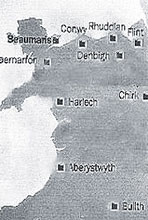Builth CastleKey facts and Information about Builth Castle - The location of Builth Castle - Clwyd
- The building of Builth Castle started in 1277
- The building of Builth Castle was completed in 1280
- The Architecture / Style - Gothic Architecture aka Edwardian
- The original cost of building Builth Castle - £16,666
The Building of Builth Castle
The history of the building of Builth Castle is fascinating. In just a relatively short period of time a significant number of new Welsh Medieval Castles were built or modernised under the instructions of King Edward I (1272-1307) including Builth Castle. King Edward employed the services of an architect and master builder called Master James of St George to carry out many of these ambitious plans for a chain of Medieval castles to be built in Wales. Builth - A Concentric Castle Design
Welsh Castles including Builth Castle, built by Edward I, are referred to as Concentric Castles. The Gothic architecture of the Medieval era together with the design of Concentric Castles encompassed some, or all, of the following elements: - A Stronger central Keep or Main Tower
- A Round or Circular Shaped Keep
- A High wall, complete with towers surrounded the Keep and the Inner Bailey
- At least one lower, outer wall surrounded the Inner High Wall
- Several Outer Walls and Outer Baileys were often added!
- Several Gatehouses were featured
- Moats were added which surrounded the whole Concentric Castle complex
Concentric castles were bigger than any previous castles! The walls were thicker, stronger and higher with turrets! The Inner Walls were higher than Outer walls! Drawbridges were added! The interiors were more comfortable, even luxurious! Concentric Castles, like Builth, were very expensive! The Builth Castle
Builth Castle was one of the ten key Welsh Medieval Castles which were commissioned by King Edward I. The Welsh Medieval Castles built by the English under the direction of King Edward I provided a power base for the Medieval Plantagenet King and ensured that the Welsh were subservient to the new English rule. | 
